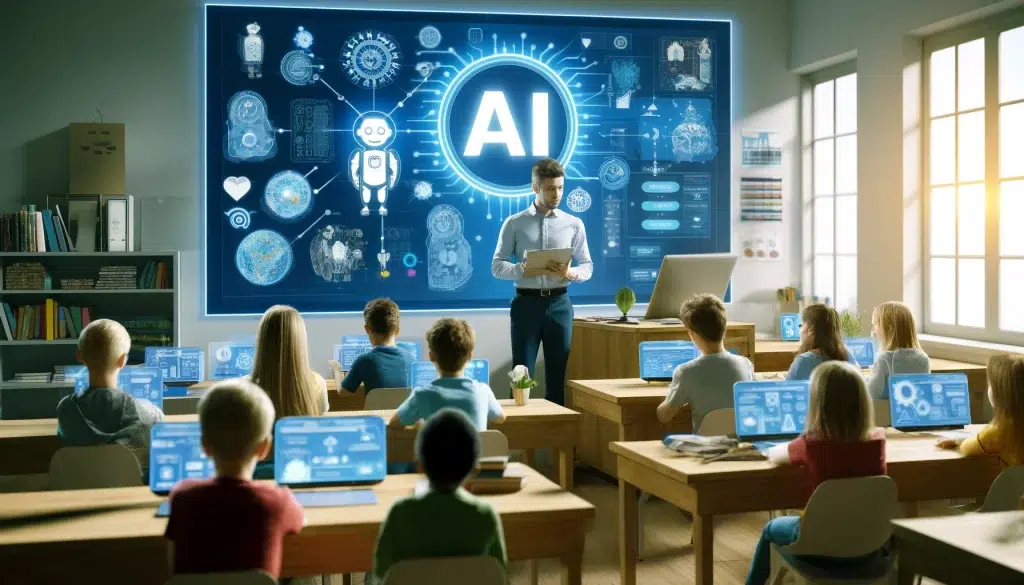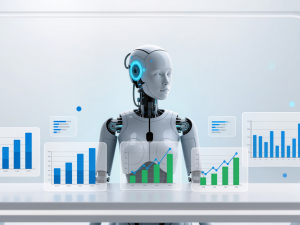In many rural schools, one teacher often juggles an entire classroom of students each with different strengths, learning speeds, and challenges. Textbooks are scarce, digital access is limited, and one-on-one attention is a rare luxury. Yet quietly, a new kind of support is changing this reality. Artificial Intelligence is stepping into classrooms as a mentor, not a replacement, helping teachers do what once felt impossible.
AI-driven tools are bringing personalisation and precision to education where resources are stretched thin. They assess how each student learns, identify weak areas, and adjust lessons in real time. For a child in a remote village, this means receiving the same level of personalised feedback and guidance as someone in a well-equipped city school.
But AI’s impact goes beyond academics. It offers consistent mentorship, motivation, and support even outside school hours. It’s creating a world where learning doesn’t stop when the bell rings, and where location no longer decides opportunity.
In this new model of education, technology becomes a partner to teachers and a lifeline for students building a bridge across the divide that has long separated rural classrooms from the rest.
How Can AI Bridge the Digital Divide in Education?
The gap between rural and urban education has always been about more than distance; it’s about access. Access to teachers, updated materials, and individual attention. AI is beginning to change that by making learning scalable, affordable, and personalised, even in areas where resources are scarce.
At its core, Artificial Intelligence brings adaptability into classrooms. It studies how students interact with lessons, their pace, accuracy, and engagement then adjusts the content automatically. If a student struggles with fractions, the AI slows down, adds visual explanations, or switches to interactive exercises. If another student races ahead, it introduces more complex problems to keep them challenged. This kind of flexibility, nearly impossible for one teacher managing 40 or 50 students, helps each learner progress at their own rhythm.
AI also makes learning continuous. With low-bandwidth or offline-compatible apps, students can keep studying from home or community centres, even without full-time internet access. Many of these platforms are multilingual, breaking down language barriers that often limit rural students. For schools where teachers are few, AI tutors fill the gap offering 24/7 guidance, quizzes, and instant feedback.
Perhaps most importantly, AI helps level the field. By offering the same high-quality content and personalised support everywhere, it gives students in rural classrooms the same chance to succeed as those in elite schools. Teachers benefit too AI tools provide performance dashboards showing where students struggle, helping educators focus their efforts where it matters most.
With every test scored and every question answered, AI reduces the weight on teachers’ shoulders while giving students the attention they’ve always needed. It’s not just closing the digital divide, it’s rebuilding education around equality and possibility.
What Does AI Mentorship Look Like in Rural Classrooms?
AI mentorship isn’t about replacing teachers, it’s about giving every student a digital companion that understands how they learn best. In rural classrooms, where one teacher often guides dozens of learners, this technology becomes a second set of eyes and ears attentive, adaptive, and always available.
Here’s how it works. AI tutors track each student’s progress across subjects, identifying where they excel and where they struggle. If a student repeatedly makes errors in multiplication, the system doesn’t just mark it wrong, it offers simpler examples, visual explanations, or even short practice games to rebuild understanding. For another student who finishes early, the AI might suggest advanced exercises or real-world applications to keep them challenged. This constant adjustment turns the classroom into a dynamic space where no one feels left behind or held back.
Another major strength of AI mentorship is instant feedback. In traditional classrooms, students might wait days for graded assignments. With AI, feedback is immediate. The moment an error occurs, the system explains why reinforcing learning when it’s most effective. This not only speeds up improvement but keeps students motivated by showing progress in real time.
Some advanced tools even include emotional analytics tracking patterns like hesitation, disengagement, or frustration. When the AI senses a student is struggling, it can suggest breaks, encouragement, or notify the teacher that extra attention is needed. This helps teachers respond faster and with more empathy, even in large groups.
For educators, AI mentorship acts as a silent collaborator. Dashboards summarise class performance, highlight common problem areas, and recommend tailored interventions. Instead of spending hours grading, teachers can focus on mentoring, discussion, and creativity the things no machine can replicate.
In short, AI mentorship is making classrooms more personal, even in places once defined by scarcity. It’s giving rural students a chance to be seen, heard, and guided in ways that were once only possible in one-on-one settings. And as these tools grow smarter, the results are beginning to show better engagement, higher scores, and renewed confidence among learners who finally feel supported.
How Does AI Improve Learning Outcomes and Accessibility?
The biggest proof of AI’s impact isn’t found in its algorithms, it’s in how students start to learn differently. Rural classrooms that once relied solely on rote learning are now becoming spaces for discovery, driven by curiosity and feedback. With AI mentorship in place, students are not just memorising lessons; they’re understanding them.
One of the clearest advantages is improved academic performance. Studies and pilot projects across developing regions show that students using AI-based tools often perform better in tests compared to those learning through traditional methods. This isn’t because AI teaches faster, it’s because it teaches differently. By identifying learning gaps early and adapting lessons, it helps students master concepts before moving forward. That builds confidence and retention, two ingredients often missing in conventional, exam-heavy education systems.
Then there’s accessibility. In areas where schools close during monsoons or lack enough staff, AI platforms keep learning going. With 24/7 access through phones or tablets, students can revise lessons anytime, anywhere. Open-access apps are also democratising education giving rural learners the same quality of content as students in well-funded institutions.
For teachers, AI creates visibility that wasn’t possible before. Performance dashboards show which students are struggling, which topics need more attention, and which teaching strategies are working. Instead of reacting after a test, teachers can intervene early making classroom instruction more data-driven and effective.
Another overlooked benefit is motivation. When students receive instant feedback or see visual progress on-screen, learning starts to feel rewarding. AI systems use gamification, quizzes, and progress trackers to keep them engaged, turning practice into something closer to play.
Most importantly, AI mentorship builds consistency. It ensures that even when resources are stretched thin or teachers are unavailable, students still have access to guidance. This constant learning loop personalised, adaptive, and uninterrupted is what makes AI such a powerful equaliser.
For rural schools long left behind by limited access and infrastructure, this technology doesn’t just support education it redefines what access means. Every student, regardless of where they live, can now have a mentor who never stops teaching, supporting, or believing in their potential.
Balancing AI and Human Mentorship: Finding the Right Mix
For all the progress AI brings, one truth remains: no technology can replace the empathy, intuition, and connection of a real teacher. That’s why the most successful classrooms use AI not as a substitute, but as a partner in mentorship. The balance between the two is what defines meaningful learning in rural settings.
When implemented thoughtfully, AI becomes an extension of the teacher’s reach. It handles time-consuming tasks like grading, tracking attendance, or analysing performance, freeing educators to focus on what truly matters: conversations, creativity, and personal guidance. Teachers shift from being information providers to tech-empowered mentors professionals who interpret data from AI dashboards and use it to support students more effectively.
At the same time, students benefit from a hybrid model of mentorship. They learn independently through AI-driven lessons, then apply that knowledge through discussions, group projects, or community-based activities with their teachers. This mix of digital feedback and human interaction nurtures both cognitive and emotional growth.
Of course, finding the right balance isn’t always easy. AI can sometimes push standardised patterns of learning that clash with the local context or the teacher’s personal approach. That’s where teacher training becomes essential, helping educators understand how to use AI tools wisely, adapt them to their classrooms, and maintain their own unique teaching style.
There’s also the question of trust. For AI to truly work, teachers need to believe in its insights, and students need to feel supported by it not monitored. When technology is framed as an ally rather than an overseer, it strengthens the learning bond instead of disrupting it.
In the end, the goal isn’t to choose between human and artificial mentorship, it’s to blend the best of both. Teachers bring warmth, context, and motivation; AI brings consistency, data, and personalisation. Together, they can reach students in ways neither could alone, especially in classrooms where resources are limited but ambition runs high.
Challenges and Considerations
AI mentorship holds enormous promise, but its success depends on how responsibly and inclusively it’s implemented. Rural schools face unique barriers, some technical, others social that must be addressed for this innovation to truly deliver on its potential.
The most visible challenge is access. Many rural communities still lack stable internet connectivity, reliable power supply, or devices like tablets and laptops. Without these, even the smartest AI system can’t function. Solutions such as offline-compatible platforms, solar-powered devices, and low-data tools are beginning to bridge this gap, but widespread infrastructure support remains essential.
Then there’s teacher preparedness. For AI to work well, educators need training not just in using the software, but in interpreting its insights and blending them into everyday lessons. Without this, technology risks becoming an underused add-on rather than a teaching partner.
Another concern is data privacy and algorithmic bias. AI platforms collect large amounts of student information performance, behaviour, even emotional cues. Safeguarding this data and ensuring algorithms remain unbiased toward gender, language, or economic background is critical. In rural settings, where awareness of digital rights is often limited, strong privacy frameworks are non-negotiable.
Finally, there’s the risk of over-reliance on technology. If used without balance, AI could unintentionally make learning impersonal. The human connection the encouragement, humour, and empathy a teacher brings must remain at the heart of education.
The path ahead lies in thoughtful implementation: technology that’s inclusive, transparent, and human-first. Only then can AI mentorship uplift rural education instead of widening existing divides.
The Future of AI Mentorship: Empowering Every Learner
The promise of AI in education isn’t just about smart algorithms or data-driven lessons, it’s about giving every child, no matter where they live, a fair chance to learn, grow, and dream. In the years ahead, AI mentorship could redefine what equality in education truly means.
Imagine a world where a student in a remote village learns science through the same AI-powered platform used by a student in a major city. Where progress isn’t measured by geography, but by curiosity and effort. AI mentorship has the potential to make that vision real by personalising learning, providing instant feedback, and extending support far beyond the walls of the classroom.
As technology advances, these systems will become even more intuitive and inclusive. They’ll recognise emotional cues, switch languages seamlessly, and adapt lessons to local contexts and cultures. For teachers, this evolution means more insight and support; for students, it means more independence and confidence in their learning journey.
But the most important part of the future isn’t the technology itself, it’s how we use it. When designed ethically, implemented equitably, and guided by educators, AI mentorship can become a tool for empowerment, not exclusion. It can ensure that no child’s potential is limited by where they were born or what resources their school can afford.
In many ways, AI mentorship represents the most human use of technology yet not to replace people, but to lift them. And if it continues to evolve in this direction, it could transform not just classrooms, but entire communities one student, one mentor, one connection at a time.
FAQs:
1. How does AI mentorship work in rural schools?
AI mentorship uses intelligent software to analyse each student’s progress, identify learning gaps, and personalise lessons accordingly. These systems can provide instant feedback, recommend exercises, and offer support even outside school hours making education more consistent and accessible for rural learners.
2. Can AI replace teachers in under-resourced classrooms?
No, and it shouldn’t. AI is designed to assist, not replace, teachers. It automates repetitive tasks like grading or tracking progress, freeing educators to focus on personal interaction, creativity, and emotional guidance, things no machine can replicate.
3. How does AI improve accessibility for low-income students?
AI platforms, especially those built for low-bandwidth or offline access, allow students to learn anytime, even without a stable internet. Many are open-access and multilingual, ensuring affordability and inclusivity for students from diverse backgrounds.
4. What are the main challenges in using AI for rural education?
Limited connectivity, lack of digital infrastructure, data privacy concerns, and insufficient teacher training are key challenges. Successful implementation depends on balancing technology with equity, training, and ethical standards.
5. How can schools ensure AI use remains ethical and inclusive?
Schools must prioritise transparency, consent, and strong data protection. They should also ensure that AI tools are regularly audited for bias and that teachers are equipped to interpret and manage AI-generated insights responsibly






